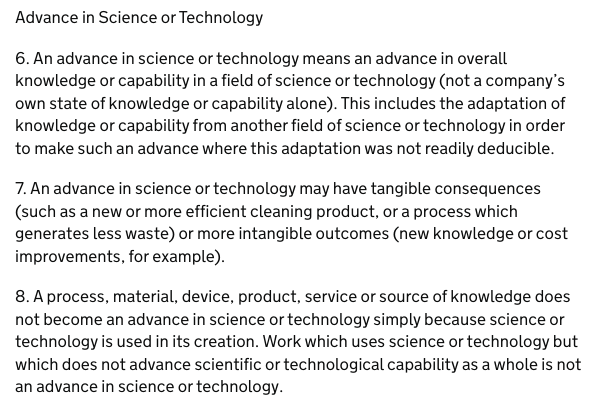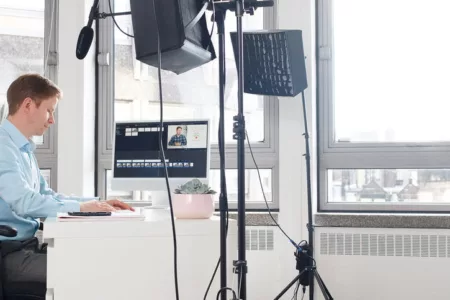There are two areas where it’s easy to make mistakes with eligibility. Firstly, you have to start with HMRC’s abstract, subjective definition of R&D and work out how it applies to each client’s technology. That’s pretty subjective and there’s no set way to do it, so it’s easy to feel outside your comfort zone.
Secondly, it’s not just you who has to understand the guidance – you also have to be able to explain it clearly to your client. Clients expect you to have a handle on everything that relates to “tax,” without having the broader view of how complex the scheme is, and expect you to talk like an expert even when you don’t feel like one. Just trying to explain whether (or if) a client is eligible can feel daunting when you’re not 100% sure of yourself.
Just to add to the pressure, when you go looking for information there’s a lot of rubbish out there. Some ‘explanations’ make out that almost anything should qualify as R&D, and many examples online are so high-level they’re next to useless. You can spend ages searching yet find nothing particularly useful, so you’re still unsure even after burning all that time.
To help you side-step some common issues, we’ve compiled a list of the top 5 mistakes we’ve seen accountants make when discussing eligibility with their clients. These are the most common ways that problems can sneak in, so let’s avoid them if we can!
#5 – Not showing your client the guidance from HMRC
The very fact that trying to apply the guidance is so (potentially) confusing means it’s tempting not to show it to the client directly. After all, most don’t read it – they’d rather you gave them a short précis than drag them through all the gory details.
In reality, however, it makes sense to do both. Show them what the guidance says and talk them through key terms like “technological uncertainty” and “appreciable improvement.” The more they understand about HMRC’s definition of R&D, the easier it is for you to discuss which parts of their projects fit the definition.
There’s another important advantage too. If you wind up with a Compliance Check from HMRC, they’ll want to know what you told your client about the activities they could claim for. They want to find out whether the client was mis-advised, and why mistakes were made.
Sharing the guidance with your client means that if the claim does go to enquiry, you’ll be able to show that you did everything you could to help them understand the rules. This protects your reputation by showing that you took due care to ensure that the client was well-informed going into the process. If you don’t make a point of sharing the guidance, you might find that the client is quick to point the finger in your direction if there’s an enquiry.
Related: 3 steps to effective R&D eligibility screening conversations
#4 – Sticking to the same approach as your client’s business grows
In smaller companies, the MD usually has a good handle on the technical detail of all the company’s projects. As the company grows, however, the MD often starts to concentrate on more strategic or commercial matters. At that point you have to bring other staff into the process, because HMRC only give relief for technological advances, not commercial ones. It’s easy to get caught out by continuing to rely exclusively on the MD for technical input, even when they’ve taken one or two steps back from the projects’ technical detail.
We’ve also seen accountants run into problems by claiming 100% of the core development team as the company grows. While it can make sense for a young company, this approach doesn’t take into account that product development teams generally spend more time on routine tasks as they get larger. That makes 100% apportionments hard to defend as the company grows, and – even worse – they’re easy for HMRC to spot, so frequently act as enquiry-triggers.
#3 – Assuming that an advance in technology is enough on its own.
Sometimes a client will ask you to claim for work that’s an obvious advance in technology within their sector. What they’ve achieved is better than anything else out there. So that’s an R&D slam-dunk, right?
Not necessarily.
HMRC’s definition has two parts – it states that R&D is where the client is trying to “advance technology” by “resolving technological uncertainty.” This means that if the client was able to make an advance without any kind of challenge or difficulty, they shouldn’t be claiming for that, because there wasn’t any technological uncertainty.
So when a client comes to you with a whizz-bang new product or prototype, that’s great – but definitely not the whole story! Make sure you ask them what technical difficulties and challenges they had in bringing it to life. If there weren’t any, then they’re not eligible.
#2 – Assuming that having patents = eligible work.
This is an easy mistake to make. Having a patent means that the client has designed something that’s different to everything else. But being different doesn’t always mean that it’s better, or that it meets HMRC’s definition of R&D. The work must represent an advance, as well as being different.
There is a relationship between patents and R&D tax relief, however. While not all patents will be for things that are technologically better, most solutions that are technologically better are likely to be patentable.
So, by all means ask your clients if they have any patented solutions, but don’t stop there. Make sure you then ask them i) how the patented item advanced technology and ii) what technical challenges arose in its creation.
#1 – Always concentrating on the low-hanging fruit.
The number one mistake accountants make is being reactive, rather than proactive, with their client portfolio. It’s so much easier to focus on the clients that self-identify as having qualifying R&D work – especially when you’ve already got a lot on your plate.
Unfortunately, there are plenty of other people out there looking for new R&D clients, and they make a lot of calls and knock on a lot of doors. When they find one of your clients, you can find yourself on the back foot. Either you have to explain why they aren’t eligible, or you have to explain why you weren’t the first to tell them about a significant source of income. From a client management perspective, that can get awkward.
One way to solve this is to pre-emptively screen your client portfolio, to ensure you’re the one bringing up R&D as soon as possible. This involves training your broader team in R&D and what it looks like, so that they can screen clients and refer them to you for investigation. If your team knows more about the R&D scheme in general, you’ll miss fewer opportunities, have fewer stressful conversations, and feel in much more control of what’s happening within your client portfolio.
Want to learn more about eligibility?
Members of The R&D Community get access to the course Establishing Eligibility – How to discuss R&D with clients along with a range of other training courses. If you’re interested, you read more about our training and find out how to sign up.






